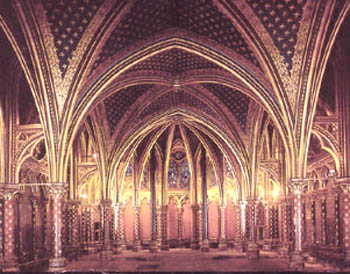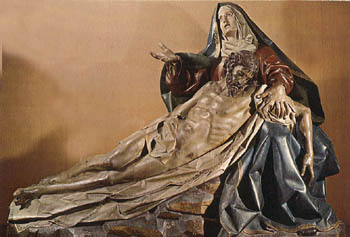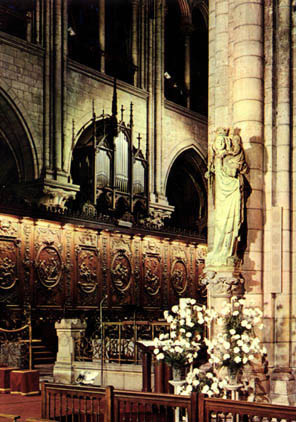 |
Theology of History
The Immaculate Character
of the Catholic Church
Prof. Plinio Corrêa de Oliveira
The attributes of Our Lady and those of the Catholic Church are interchangeable. Many things we say about Our Lady, we can also say about the Holy Church. If we were to pray the Litany of Our Lady or the Salve Regina and apply each one of those titles to the Holy Church, we would see that they are interchangeable and apply beautifully. Obviously, one needs to know how to make the transposition. A certain adaptation is necessary.

Sainte Chapelle Chapel in Paris represents
the perennial radiance of the Catholic Church. |
One such application regards the Immaculate Conception of Our Lady, which relates to the immaculate character of the Church that came from the Redemption. Just as Our Lady has no stain of original sin, the Church has no element of original sin in herself. The liturgy applies to the Church that Scriptures passage which says she is without stain or wrinkle, but is always young, beautiful and holy (Eph 5:27; Cant 4:7). We can say the same of Our Lady, a woman without stain or wrinkle as a consequence of her Immaculate Conception. In her there is no blemish, no weakness, no fatigue, because these things came to humankind with original sin.
This perennial radiance of Our Lady can also be seen in the character of the Catholic Church. We are reminded, however, that notwithstanding her splendor, there was a moment when she appears to us as the Mother of Sorrows, when she was emerged in the most profound mourning ever felt in History for the death of her Divine Son. The words of the Prophet Jeremiah were applied to that enormous grief of Our Lady: “All ye that pass by, behold, and see if there be any sorrow like unto my sorrow?” (Lam 1:13)

The compassion of Our Lady appears in "La Piedad,"
Valladolid, Spain |
At this moment in History, this same lamentation applies to the Catholic Church. We should ask Our Lady to conserve in us the vision of the immutable radiant and immaculate character of the Holy Church, despite the profound grief she suffers at the present time. We should ask Our Lady to give us a grace that is very similar to the grace of having devotion to her, which is the grace of having a profound, imperturbable, and invincible devotion to the Catholic Church, though today she is in a situation analogous to that of Our Lady on Good Friday. The same lamentation of Jeremiah can be applied to the Catholic Church today: “All ye that pass by, behold, and see if there be any sorrow like unto my sorrow?” She poses this question to her true children regarding the situation she is passing through now.
In the uncertainty of our days, we should remember that the Catholic Church continues to be perfectly radiant, infallible, and immaculate in her substance despite the errors that Progressivism is introducing inside her boson. The Church in herself remains spotless and without stain despite all the bad use that the ecclesiastical authority is making of its power, which makes it appear that the Church has joined the party of the Revolution.
Even though many religious authorities give the impression that truth is error, and error is truth, nothing can obliterate the immaculate character of the Catholic Church. Her immaculate character depends solely on her unyielding fidelity to Our Lord Jesus Christ, on her immutable infallibility. Regardless of how enormous the abuse of the human power within the Church may be, speaking in the absolute sense, the Catholic Church remains majestic and victorious, just as Our Lady was at the foot of the Cross. The Mother of Sorrows, overwhelmed by suffering, continued to be a majestic and victorious Queen even in that very episode that simultaneously marked her greatest apparent defeat.

The Holy Virgin in Notre Dame Cathedral, Paris.
Many attributes of Our Lady and the Church are interchangeable. |
Since the sin of Revolution has reached such an extreme point, we should consider that it may be according to the plans of God and the profound order of the things in the universe that the complicity of the human element of the Church should be so great. The dignity of the Church remains. What happens is that the human element that falls into error and behaves badly instinctively moves away from her spirit, her doctrine, and her traditions, separating itself from her. Even if such element makes up part of the Hierarchy of the Church. These persons leave her alone, by herself, completely untouched by the present crisis. And she continues to be without stain or wrinkle, and the thing most worthy of love after Christ Our Lord.
The Catholic Faith does not change. It will never assimilate an error, and, therefore, it is immaculate. The sanctity of her Sacraments continues to be a source of spiritual life for the faithful. The Holy Ghost continues to act mysteriously inside the Church. With these three things, the Catholic Church continues to be herself and be immaculate.
The Catholic Church is passing through a passion similar to the passion of Our Lord, through which Our Lady also passed with her compassion. The Church is passing through a kind of crucifixion. At the moment when everything seemed lost, at the moment when Our Lord said “Consumatum est,” that was, notwithstanding, the moment of His and Our Lady’s supreme victory over the Devil. That victory was accompanied by those extraordinary phenomena that occurred in Jerusalem: the sun became dark, the bodies of just men rose from their sepulchers to give witness to Our Lord and accuse the Jews, the veil of the Temple was rent to show that the Covenant had been broken, and so on.
Similarly, in our days, at the moment when the chalice of abominations will be full and everything will seem lost for the Catholic Church, at that moment the victory of the Church over the Revolution will come, followed by the chastisements predicted at Fatima. In the end, the Reign of Mary will come.
Let us pray to Our Lady asking her to give us an extraordinary devotion to her and a similar devotion to the Holy Catholic Church, as well as an invincible faith in her divine character, her infallibility and her indestructible sanctity. She is our mother whom we love all the more when she is persecuted and mistreated by her external, and principally her internal enemies.

Posted on December 8, 2004

Related Articles of Interest
 The Immaculate Conception of Our Lady The Immaculate Conception of Our Lady
 The Fidelity of the Remnant throughout History The Fidelity of the Remnant throughout History

|
Theology of History | Religious | Home | Books | CDs | Search | Contact Us | Donate

© 2002- Tradition in Action, Inc. All Rights Reserved
|
 |
|